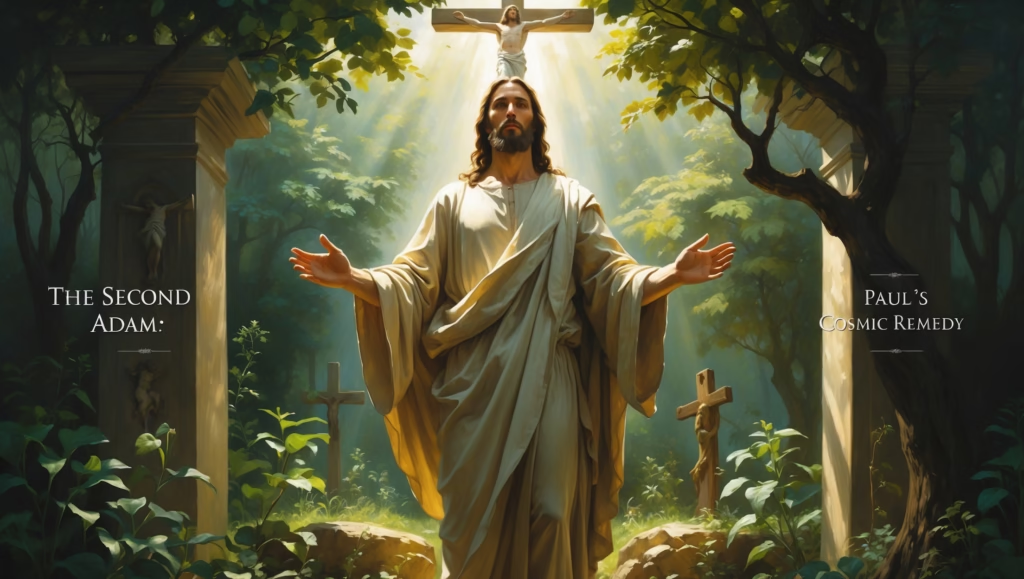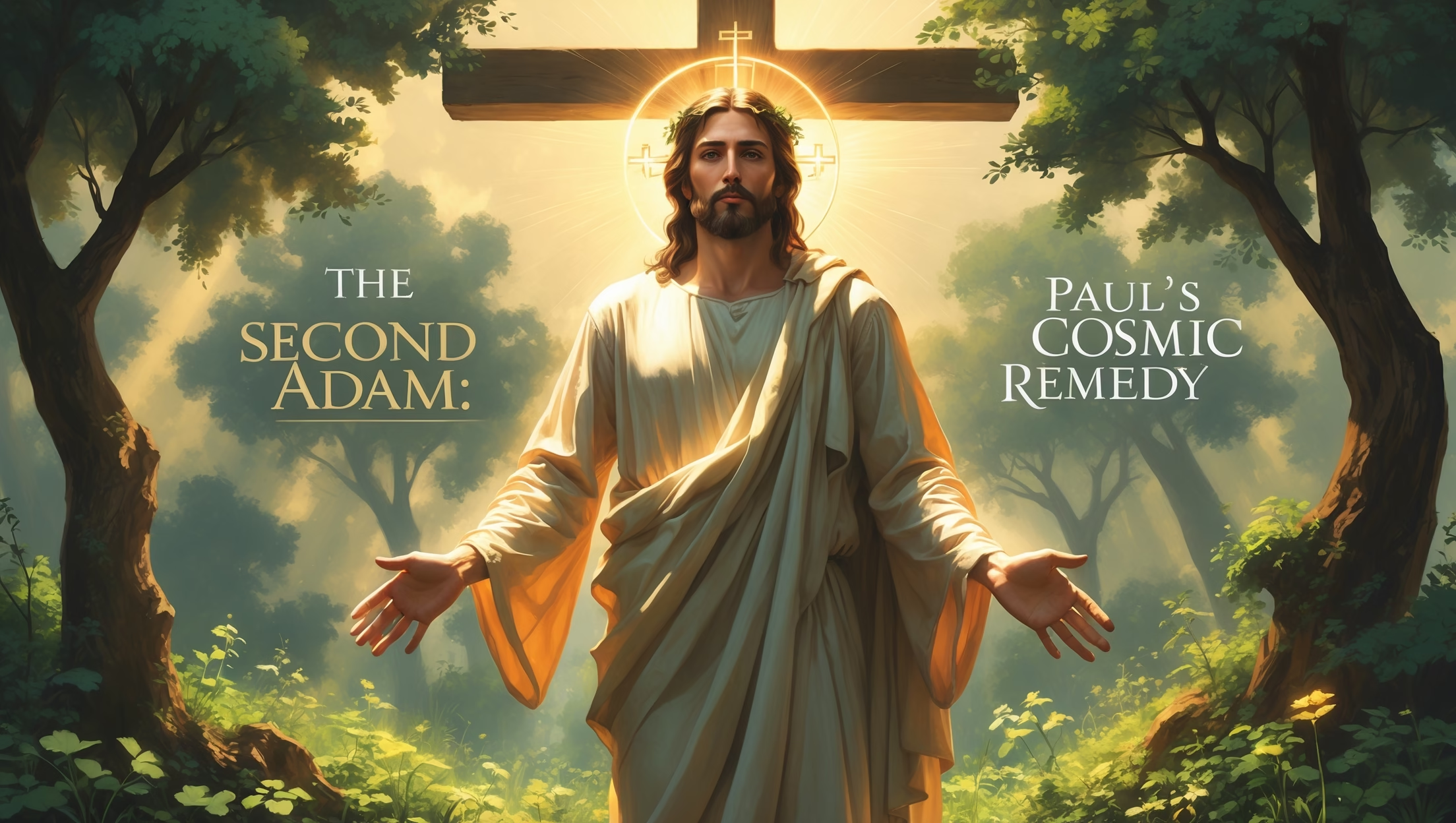How Christ Undoes Eden’s Curse
In Christian theology, the concept of Jesus as the “Second Adam” is one of the Apostle Paul’s most profound insights into salvation history. In Romans 5:12–21 and 1 Corinthians 15:21–22, 45–49, Paul draws a direct typological comparison between Adam, the head of the old humanity, and Christ, the head of the new. Adam’s disobedience brought sin, death, and alienation from God into the world; Christ’s obedience, death, and resurrection bring righteousness, life, and reconciliation. This is not merely a moral reversal—it is a cosmic remedy, a reordering of creation itself.
Paul’s vision is not limited to personal salvation but extends to the renewal of the entire cosmos. The curse that began in Eden was not just a human problem—it disrupted the harmony of creation. Through the lens of “Second Adam” theology, we see that Christ’s work is the decisive act that heals the rupture at every level: human, spiritual, and cosmic.

Typological Parallels: Eden and Calvary
Paul’s theology is rooted in biblical typology, where earlier events in Scripture foreshadow and find their fulfillment in later redemptive acts. The story of Genesis 3 is not isolated—it is a pattern that Christ, the Second Adam, intentionally enters and reverses.
1. Tree of Knowledge → Cross
In Eden, the Tree of the Knowledge of Good and Evil became the instrument through which humanity’s innocence was lost. Adam and Eve’s act of taking the forbidden fruit turned the tree into a symbol of rebellion.
At Calvary, the wooden cross becomes the new tree—this time, not a tree of disobedience, but of obedience and redemption. As 1 Peter 2:24 declares, “He himself bore our sins in his body on the tree, that we might die to sin and live to righteousness.”
The tree that once brought death is now transformed into the tree that brings life.
2. Eve’s Temptation → Mary’s “Yes”
In Eden, Eve listened to the serpent’s lie, doubted God’s word, and acted in self-interest. Her decision, partnered with Adam’s passivity, led to the fall.
In Nazareth, Mary is confronted with an angelic message that defies human logic: she will bear the Son of God. Her response—“Let it be to me according to your word” (Luke 1:38)—is an act of faith and surrender.
Mary’s “yes” functions as the human doorway through which the Second Adam enters the world, undoing the disobedience of the first pair.
3. Adam’s Hiding → Christ’s Naked Exposure
After sinning, Adam hides from God among the trees (Genesis 3:8). His fig-leaf covering is a symbol of shame and self-protection.
At the cross, Christ is stripped naked before the world. He does not hide from the Father but faces the full exposure of judgment. His vulnerability becomes the means of our covering—through His nakedness, we are clothed with righteousness (Galatians 3:27).
The shame Adam concealed, Christ bore openly, turning disgrace into glory.
4. Cherubim’s Sword → Pierced Side
After the fall, God places cherubim with a flaming sword to guard the way to the Tree of Life (Genesis 3:24). Humanity’s path to eternal life is blocked.
At the crucifixion, a Roman soldier’s spear pierces Christ’s side (John 19:34), and out flows blood and water—symbols of atonement and new life. The sword that once guarded the way is now transformed into the wound through which life flows to the world. In Christ, the way back to the Tree of Life is reopened.
The Cosmic Scope of the Second Adam
Paul’s “Second Adam” language is not just a neat theological metaphor—it reveals the scale of God’s redemption.
In Romans 8:19–23, Paul speaks of creation itself groaning, awaiting liberation. This suggests that Adam’s fall unleashed a ripple effect beyond humanity—affecting ecosystems, relationships, and the balance of life itself.
By contrast, Christ’s victory is cosmic in scope. His resurrection is the “firstfruits” (1 Corinthians 15:20) of a restored creation. The garden tomb, where He rose, mirrors Eden—but in this garden, the gardener (John 20:15) is the risen Lord who tends the new creation.
This is why Paul calls Christ the “last Adam” (1 Corinthians 15:45): there will be no need for another representative head of humanity. In Him, the curse is definitively undone.
Modern Application: Creation Groaning and Environmental Theology
Paul’s imagery in Romans 8:22—“We know that the whole creation has been groaning as in the pains of childbirth right up to the present time”—is profoundly relevant in our age of climate change, biodiversity loss, and environmental crisis.
1. Recognizing Creation’s Groaning
When forests burn, oceans acidify, and species vanish, these are not random tragedies but signs of a world still under the lingering effects of Adam’s fall. Just as human relationships are fractured, so is our relationship with the earth.
From a biblical perspective, environmental degradation is not merely a technological or political issue—it is a theological one.
2. The Second Adam and Ecological Hope
If Christ’s redemption is cosmic, then caring for creation is not an optional side project for Christians—it is part of the gospel’s outworking. The Second Adam does not only save souls; He renews creation. Every act of restoration—whether reforestation, conservation, or sustainable living—is a prophetic sign pointing toward the “new heavens and new earth” (Revelation 21:1).
3. Living as Agents of New Creation
Paul calls believers “ambassadors of reconciliation” (2 Corinthians 5:18–20). This reconciliation includes our stewardship of the natural world.
To follow the Second Adam is to live as signposts of Eden restored, embodying the truth that creation’s groaning will one day give way to creation’s singing.
Conclusion: From Eden Lost to Eden Restored
The typology of the Second Adam is a reminder that the cross is not a random execution but the deliberate reversal of Eden’s curse. Every scene in Calvary echoes Genesis 3—and in each echo, Christ emerges victorious where Adam failed.
For Paul, this is not just personal good news; it is cosmic good news. The curse that distorted humanity, severed our connection with God, and wounded creation itself is undone in Christ.
From the Tree of Knowledge to the cross, from hiding to exposure, from barred gates to an open side—history moves toward restoration. And in that restoration, not only humanity but the whole creation will be made new.








